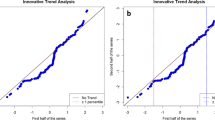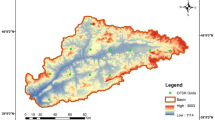Abstract
Drought is one of the important factors causing vegetation degradation. Determination of areas with vegetation more sensitive to drought can be effective in drought risk management. Considering the ability to describe vegetation conditions, vegetation health index (VHI) was used to determine the probability of vegetation vulnerability to drought and to provide the map of Iran showing sensitive areas to drought. This study tries to express the probability of vegetation vulnerability to drought in four main climatic classes including hyper-arid, arid, semi-arid and semi-humid, and humid in Iran. Temperature condition index (TCI) and vegetation condition index (VCI) were calculated using land surface temperature (LST) derived from the MOD11A2 product and normalized different vegetation index (NDVI) obtained from MOD13A2 product, MODIS sensor. Combining these two indices, VHI was calculated for late of March, April, May, and June during 2000–2017. VHI was classified into five classes representing the drought intensity. Then, the probability of occurrence (%) of each class was calculated and multiplied with weight of each class, varying from 0 to 40 based on drought intensity. Finally, probability of vegetation vulnerability index (PVVI) was calculated by summing of the values obtained for each class. The results showed that PVVI was higher in arid and hyper-arid areas than that in other areas in the four studied periods. The highest mean values of PVVI in humid as well as semi-arid and semi-humid classes were found in April as 59.87 and 62.4, respectively, while the highest mean values of PVVI in arid and hyper-arid classes were observed in May as 70.98 and 68.13, respectively. In total, our results showed that PVVI is affected by different climatic and topographic conditions, and it suggested that this index be used to determine the probability of vegetation vulnerability.






Similar content being viewed by others
References
Bajgiran, P. R., Darvishsefat, A. A., Khalili, A., & Makhdoum, M. F. (2008). Using AVHRR-based vegetation indices for drought monitoring in the northwest of Iran. Journal of Arid Environments, 72(6), 1086–1096.
Bhuiyan, C., Saha, A. K., Bandyopadhyay, N., & Kogan, F. N. (2017). Analyzing the impact of thermal stress on vegetation health and agricultural drought–a case study from Gujarat, India. GIScience & Remote Sensing, 1–22.
Bokal, S., Grobicki, A., Kindler, J., & Thalmeinerova, D. (2014). From national to regional plans—the Integrated Drought Management Programme of the Global Water Partnership for Central and Eastern Europe. Weather and Climate Extremes, 3, 37–46.
Chang, S., Wu, B., Yan, N., Davdai, B., & Nasanbat, E. (2017). Suitability assessment of satellite-derived drought indices for Mongolian grassland. Remote Sensing, 9(7), 650.
Choi, M., Jacobs, J. M., Anderson, M. C., & Bosch, D. D. (2013). Evaluation of drought indices via remotely sensed data with hydrological variables. Journal of Hydrology, 476, 265–273.
Choubin, B., Khalighi-Sigaroodi, S., Malekian, A., Ahmad, S., & Attarod, P. (2014). Drought forecasting in a semi-arid watershed using climate signals: a neuro-fuzzy modeling approach. Journal of Mountain Science, 11(6), 1593–1605.
Choubin, B., Zehtabian, G., Azareh, A., Rafiei-Sardooi, E., Sajedi-Hosseini, F., & Kişi, Ö. (2018). Precipitation forecasting using classification and regression trees (CART) model: a comparative study of different approaches. Environmental Earth Sciences, 77(8), 314,1–314,31413.
Cong, D., Zhao, S., Chen, C., & Duan, Z. (2017). Characterization of droughts during 2001–2014 based on remote sensing: a case study of Northeast China. Ecological Informatics, 39, 56–67.
Fathabadi, A., Gholami, H., Salajeghe, A., Azanivand, H., & Khosravi, H. (2009). Drought forecasting using neural network and stochastic models. Advances in Natural and Applied Sciences, 3(2), 137–146.
Field, C. B., Barros, V., Stocker, T. F., Qin, D., Dokken, D. J., & Ebi, K. L. (2012). Managing the risks of extreme events and disasters to advance climate change adaptation. A special report of working groups I and II of the intergovernmental panel on climate change. Cambridge: Cambridge University Press.
Gao, Y. H., Xu, Y. J., Yang, S. Q., Liu, C., & Ni, B. S. (2013). Research and design of a drought remote sensing monitoring system based on the ArcGIS geoprocessing technology. Journal of Southwest University (natural science edition), 35(4), 1–7.
Gomes, A. C. C., Bernardo, N., & Alcântara, E. (2017). Accessing the southeastern Brazil 2014 drought severity on the vegetation health by satellite image. Journal of Natural Hazards, 89(3), 1401–1420.
Heshmati, G. A. (2013). Indigenous plant species from the drylands of Iran, distribution and potential for habitat maintenance and repair. In Combating desertification in Asia, Africa and the Middle East (pp. 355–375). Netherlands: Springer.
Jiao, W., Zhang, L., Chang, Q., Fu, D., Cen, Y., & Tong, Q. (2016). Evaluating an enhanced vegetation condition index (VCI) based on VIUPD for drought monitoring in the continental United States. Remote Sensing, 8(3), 224.
Karnieli, A., Agam, N., Pinker, R. T., Anderson, M., Imhoff, M. L., Gutman, G. G., Panov, N., & Goldberg, A. (2010). Use of NDVI and land surface temperature for drought assessment: merits and limitations. Journal of Climate Am Meteorol Soc, 24, 618–633.
Khajoei Nasab, F., & Khosravi, A. R. (2014). Ethnobotanical study of medicinal plants of Sirjan in Kerman Province, Iran. Journal of Ethnopharmacology, 154(1), 190–197.
Khosravi, H., Haydari, E., Shekoohizadegan, S., & Zareie, S. (2017). Assessment the effect of drought on vegetation in desert area using landsat data. The Egyptian Journal of Remote Sensing and Space Science, 20, S3–S12.
Kogan, F. N. (1990). Remote sensing of weather impacts on vegetation in non-homogeneous areas. International Journal of Remote Sensing, 11, 1405–1419.
Kogan, F. N. (1995). Application of vegetation index and brightness temperature for drought detection. Advances in Space Research, 15(11), 91–100.
Kogan, F., Gitelson, A., Zakarin, E., Spivak, L., & Lebed, L. (2003). AVHRR-based spectral vegetation indices for quantitative assessment of vegetation state and productivity: calibration and validation. Photogrammetric Engineering and Remote Sensing, 69, 899–906.
Kundu, A., Dwivedi, S., & Dutta, D. (2016). Monitoring the vegetation health over India during contrasting monsoon years using satellite remote sensing indices. Arabian Journal of Geosciences, 9(2), 144.
Le Hung, T. & Hoai, D. K. (2015). Drought risk evaluation using remote sensing: a case study in BAC Binh District, Binh Thuan Province. Scientific Journal of Ho Chi Minh Educational University 5.
Lin, Y., GAO, W., Shi, J. P., & Wang, J. (2014). Remote sensing monitoring of drought based on MODIS and FY-2D satellite rainfall data. Journal of Arid Land Resources and Environment, 28(12), 51–57.
Masud, M. B., Khaliq, M. N., & Wheater, H. S. (2015). Analysis of meteorological droughts for the Saskatchewan River basin using univariate and bivariate approaches. Journal of Hydrology, 522, 452–466.
Nouri, M., Homaee, M., & Bannayan, M. (2017). Climate variability impacts on rainfed cereal yields in west and northwest Iran. International Journal of Biometeorology, 61(9), 1571–1583.
Pei, F., Wu, C., Liu, X., Li, X., Yang, K., Zhou, Y., & Xia, G. (2018). Monitoring the vegetation activity in China using vegetation health indices. Agricultural and Forest Meteorology, 248, 215–227.
Popova, Z., Ivanova, M., Martins, D., Pereira, L. S., Doneva, K., Alexandrov, V., & Kercheva, M. (2014). Vulnerability of Bulgarian agriculture to drought and climate variability with focus on rainfed maize systems. Natural Hazards, 74(2), 865–886.
Qian, X., Liang, L., Shen, Q., Sun, Q., Zhang, L., Liu, Z., & Qin, Z. (2016). Drought trends based on the VCI and its correlation with climate factors in the agricultural areas of China from 1982 to 2010. Environmental Monitoring and Assessment, 188(11), 639.
Quiring, S. M., & Ganesh, S. (2010). Evaluating the utility of the vegetation condition index (VCI) for monitoring meteorological drought in Texas. Agricultural and Forest Meteorology, 150(3), 330–339.
Rimkus, E., Stonevicius, E., Kilpys, J., Maciulyte, V., & Valiukas, D. (2017). Drought identification in the eastern Baltic region using NDVI. Earth System Dynamics, 8(3), 627–637.
Sha, S., Guo, N., Li, Y. H., Ren, Y. L., & Li, Y. P. (2013). Comparison of the vegetation condition index with meteorological drought indices: a case study in Henan province. Journal of Glaciology and Geocryology, 35(4), 990–998.
Shen, Q., Liang, L., Luo, X., Li, Y., & Zhang, L. (2017). Analysis of the spatial-temporal variation characteristics of vegetative drought and its relationship with meteorological factors in China from 1982 to 2010. Environmental Monitoring and Assessment, 189(9), 471.
Soofi, M., Ghoddousi, A., Zeppenfeld, T., Shokri, S., Soufi, M., Jafari, A., & Chahartaghi, N. R. (2018). Livestock grazing in protected areas and its effects on large mammals in the Hyrcanian forest, Iran. Biological Conservation, 217, 377–382.
Sternberg, T., Thomas, D., & Middleton, N. (2011). Drought dynamics on the Mongolian steppe 1970–2006. International Journal of Climatology, 31, 1823–1830.
Tadesse, T., Champagne, C., Wardlow, B. D., Hadwen, T. A., Brown, J. F., Demisse, G. B., & Davidson, A. M. (2017). Building the vegetation drought response index for Canada (VegDRI-Canada) to monitor agricultural drought: first results. GIScience & Remote Sensing, 54(2), 230–257.
Tran, H. T., Campbell, J. B., Tran, T. D., & Tran, H. T. (2017). Monitoring drought vulnerability using multispectral indices observed from sequential remote sensing (case study: Tuy Phong, Binh Thuan, Vietnam). GIScience & Remote Sensing, 54(2), 167–184.
Wang, H., Lin, H., & Liu, D. (2014). Remotely sensed drought index and its responses to meteorological drought in Southwest China. Remote sensing letters, 5(5), 413–422.
Wardlow, B. D., Anderson, M. C., & Verdin, J. P. (2012). Remote sensing of drought: innovative monitoring approaches. CRC Press.
Wilhite, D. A., Svoboda, M. D., & Hayes, M. J. (2007). Understanding the complex impacts of drought: a key to enhancing drought mitigation and preparedness. Water Resources Management, 21(5), 763–774.
Yu, X., He, X., Zheng, H., Guo, R., Ren, Z., Zhang, D., & Lin, J. (2014). Spatial and temporal analysis of drought risk during the crop-growing season over northeast China. Natural Hazards, 71(1), 275–289.
Zhang, L., Jiao, W., Zhang, H., Huang, C., & Tong, Q. (2017). Studying drought phenomena in the continental United States in 2011 and 2012 using various drought indices. Remote Sensing of Environment, 190, 96–106.
Author information
Authors and Affiliations
Corresponding author
Rights and permissions
About this article
Cite this article
Alamdarloo, E.H., Manesh, M.B. & Khosravi, H. Probability assessment of vegetation vulnerability to drought based on remote sensing data. Environ Monit Assess 190, 702 (2018). https://doi.org/10.1007/s10661-018-7089-1
Received:
Accepted:
Published:
DOI: https://doi.org/10.1007/s10661-018-7089-1




